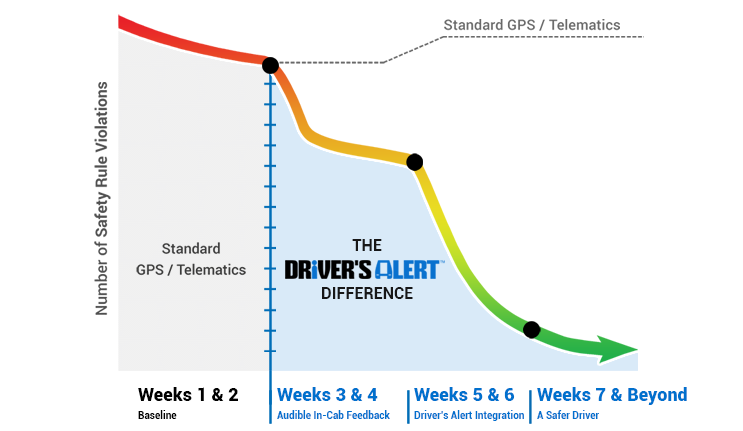Thousands of years ago, Aristotle stated that “it is frequent repetition that produces a natural tendency.” It is a philosophy that I reiterate to my own employees and is easily relatable to safe driving behaviors. This is what I want to share with you – a way to train your fleet drivers to not only learn safe driving practices, but to transform these practices into permanent behavior. What I am going to illustrate is a method for virtually eliminating driving accidents in your fleet. And it all happens in a matter of weeks, not months.
To date, most of the buzz surrounding fleet telematics has been focused on increasing the operational efficiencies of commercial fleets. Route optimization, idle time, fuel economy and engine diagnostics have been the order of business. However, many fleet managers are beginning to appreciate that a safe driver is a more efficient driver. This is why safety-based telematics is attracting attention.
In deploying telematics for fleet safety, you can shape driver behavior through repetition. By remotely tracking in real time at-risk behaviors such as hard braking, harsh cornering, and rapid acceleration, fleet managers now have the data they need to review these unsafe acts with their drivers and prevent the occurrence of costly accidents.
Of course, the results of this program extend beyond safety to include increased operational savings via reduced maintenance costs (e.g., brakes last longer when hard braking is avoided), improved fuel efficiency (e.g., less aggressive acceleration leads to higher MPG averages) and reduced tire wear (e.g., smooth cornering preserves tire tread). The foundation of your company’s fleet safety and operations programs sits behind the wheel of each and every one of your vehicles. If the foundation has cracks, a relatively good, strong machine will easily come crumbling down.
SO WHAT DOES SAFETY-BASED TELEMATICS DONE RIGHT LOOK LIKE?
Proving it Works
Whether your company starts with a pilot program or implements safety-based telematics across the entire fleet, the first few weeks are critical in ensuring you collect meaningful data that proves just how well the program is working.
To Tell or Not to Tell
The first step is to install a telematics device in each one of the fleet vehicles you want to monitor. However, the decision whether or not to make drivers aware of the installed telematics unit is dependent on organizational culture. Every organization’s culture is different. There is no simple answer. But research professionals strongly agree that the best way to capture objective data is by conducting blind testing. And this is exactly what we have found. When drivers are not privy to the device, they continue to drive as they always do, establishing a strong baseline of data that sets the stage for producing the type of dramatic results seen in the above graph.
Baseline Data
The next step in the process is to collect data for two weeks. This will ensure captured data includes a variety of driving conditions, environments, routes and traffic patterns—generating a data sample that is truly representative of the driving behaviors of your overall fleet.
After the two-week period has been completed, fleet managers will need to review the data to evaluate what areas of improvement exist and decide on appropriate thresholds for undesirable behaviors. From here, each device needs to be configured to emit an audible alarm anytime the driver exceeds one of the thresholds that has been established.
Practice Makes Perfect?
Leaders will then need to sit down with each driver, discuss the results of the data gathering and share with them what the organization is trying to accomplish with the telematics program. Never present the program as a fault-finding endeavor. This evokes punitive connotations. Always frame the program in a positive light by introducing it as a way to improve driver productivity, make the company more competitive and ensure employees go home safely.
At this stage, the audible alerts feature is operational. Over the course of the next two weeks, drivers will now be alerted by the telematics device each time a threshold is exceeded. However, safety rule violations will not be reported to supervisors.
In weeks 5 and 6, the management reporting feature should be activated, allowing fleet supervisors the ability to see safety rule violations. It is important to note that managers have the authority to set a grace period, giving drivers an opportunity to hear the audible alert and correct an unsafe behavior in real time before a safety rule violation is actually reported to a manager. This is an extremely effective and non-threatening method for permanently improving driver behavior.
As we know, practice does not make perfect, especially if the practice is being done incorrectly. If a driver is consistently making the same errors, this undesirable repetition will be “learned.” Continuous gathering of data and proactive action by managers is an important component of a sound fleet safety program.
Coaching and Mentoring
The best athletes do not achieve and maintain a high level of performance without ongoing, meticulous interaction with a professional coach. Fleet managers must do their part by recognizing drivers when they exhibit safe driving habits and creating an environment that promotes continuous training to fix the areas where there are lingering problems. The data that a well-structured safety-based telematics program provides gives you all the tools you need to be a strong mentor to your drivers, who can carry that training with them every time they drive one of your vehicles.
Repetition builds retention. For thousands of years, this has been a proven fact. With safety-based telematics, you can take complete control over your fleet safety management program – helping drivers learn, repeat and retain the type of safe driving habits that will have lasting positive effects on your company’s bottom line.
Want more? Reserve your spot at this FREE event: 7 Ways to Become a Fleet Safety Management Rock Star!

